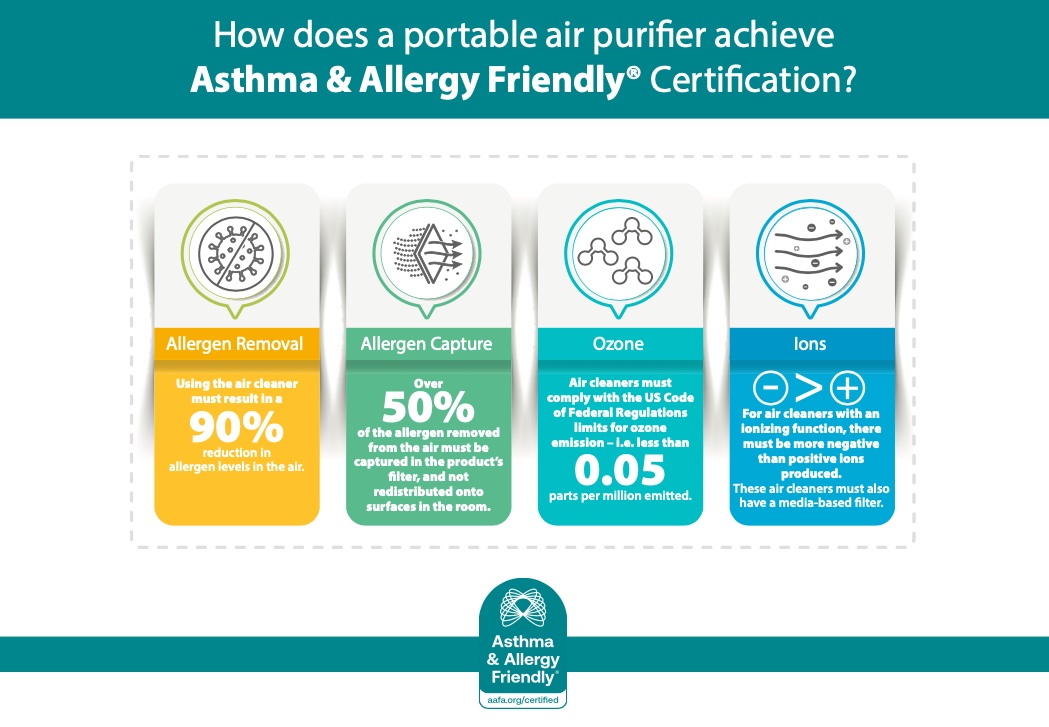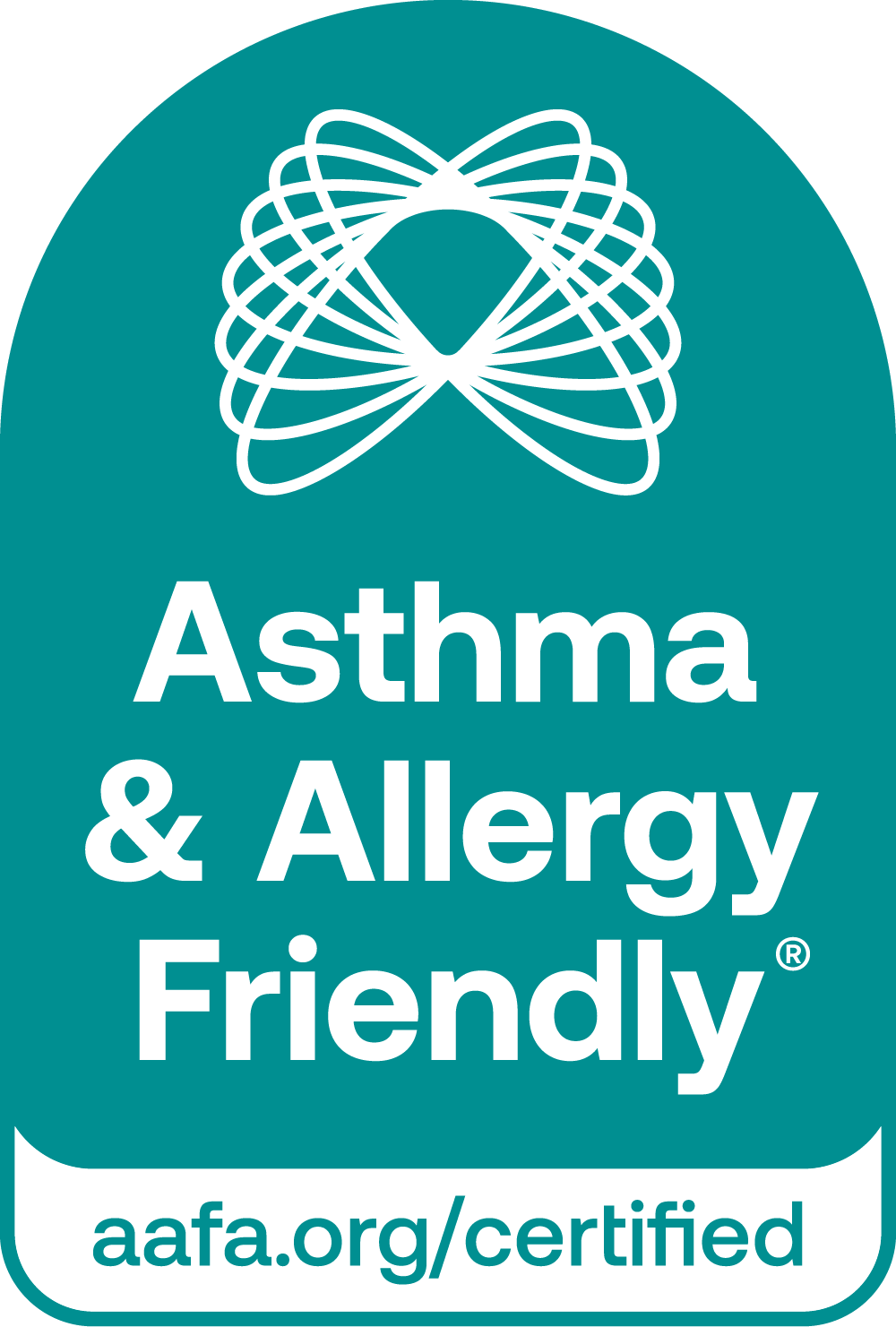Learn how portable air cleaners can significantly improve indoor air quality by reducing allergens and pollutants, and why choosing a scientifically validated device can create a healthier living space
May is recognized as Asthma and Allergy Awareness Month, a time to highlight the challenges of asthma and allergies and their profound impact on individuals and families. Since 1984, the Asthma and Allergy Foundation of America (AAFA) has designated May to raise awareness about the significance of proper diagnosis, treatment, and ongoing management of these conditions.
With asthma and allergy symptoms reaching their peak during the Spring season, this is a perfect time to inform and educate those around us about asthma and allergies and emphasize the critical role that indoor air quality (IAQ) plays in managing these health concerns.
Ensuring clean indoor air is one of the most important steps we can take toward maintaining a healthy living space. Surprisingly, the air inside our homes can often be more harmful than the air outside, as it contains a variety of pollutants. Day-to-day activities such as cooking, cleaning, painting and even burning fuel (and candles!) release particles and chemicals like Volatile Organic Compounds (VOCs) into the air. It’s clear that indoor air quality can have a serious impact on our health.
One of the most effective ways to achieve cleaner air is by using a portable air cleaner. These devices can significantly reduce airborne allergens and pollutants, helping create a healthier environment for you and your family. Indoor air pollution ranks among the top five environmental risks to public health, and with more of us spending time indoors, portable air cleaners can be a game changer for anyone seeking better IAQ, especially for individuals with asthma and allergies. Let’s explore why these devices matter and how to make sure you’re selecting one that truly works for you.
Why Air Quality Matters Now More Than Ever
We know the dangers of poor outdoor air quality—from car exhaust to industrial pollution—but did you know that indoor air can be up to five times more polluted? Dust mite allergen, pollen, pet dander, and mold spores circulate in the air and settle on surfaces, only to be stirred up again when you walk across the room or sit on the couch. If you or a family member has asthma or allergies, these particles can trigger symptoms, making it hard to find relief indoors.
That’s where portable air cleaners come in. Designed to filter out these irritants, portable air cleaners can help create a healthier living environment. But not all devices are created equal, and understanding what makes a good air cleaner is key to making an informed purchase.
What Makes an Effective Portable Air Cleaner?
While many air cleaners promise to improve indoor air, how many manufacturers can back those claims with solid scientific evidence? The Asthma & Allergy Friendly® Certification Program was developed to give consumers confidence by rigorously testing products in real-world conditions. A portable air cleaner must meet strict performance standards before earning this certification, ensuring that it not only removes allergens but also prevents them from re-entering the air you breathe.
Here’s what goes into certifying a portable air cleaner:
- Removing Allergens from the Air: To earn the Asthma & Allergy Friendly®Certification, air cleaners must reduce airborne allergen levels by at least 90%. Testing simulates real-life scenarios in a controlled chamber, complete with carpet, furniture, and allergen-laden dust. The air cleaner must prove its ability to capture allergens of different sizes like dust mite allergen, pollen, and cat allergen particles.
- Capturing the Allergen, Not Just Moving It: It’s not enough to just filter the air. Certified air cleaners must also demonstrate that they capture the allergens in their filter rather than just moving them to another surface where they could be stirred up again. At least 50% of the allergens removed from the air must be captured within the air cleaner’s filter.
- Keeping You Safe from Ozone: Some air cleaners generate ozone, a gas that can irritate the lungs and worsen respiratory issues, particularly in people with asthma. The Asthma & Allergy Friendly®Certification ensures that any ozone produced by the air cleaner is kept at extremely low levels (less than 0.05ppm), making it safe for indoor use.

Types of Filtration to Consider
There are several types of filtration technology used in portable air cleaners, and knowing the difference can help you make a more informed choice.
∙ HEPA Filters: Simply put, this is a fine mesh folded a bit like an accordion that traps particles as air is pushed through it by a fan. It can trap 99.97% of particles 0.3 microns or larger. These filters trap common allergens like dust, pollen, and pet dander.
∙ Activated Carbon Filters: These filters are great for tackling gases and odors, like those from household cleaning products or paint. While they may not capture allergens, combining a HEPA filter with an activated carbon filter can tackle both particulate matter and odors.
∙ Electrostatic Filters: These filters charge particles as they pass through, causing them to stick to metal plates. While effective at trapping particles, it’s important to ensure they don’t generate harmful ozone.
∙ UV Light: UV light is capable of killing microorganisms, and UV light sources can sometimes be present in room air cleaners, and also in HVAC systems. UV light requires time to kill microorganisms, so make sure it’s actually effective, rather than just a sales pitch!
∙ Ionizers and Ozone Generators: Air cleaners that emit harmful quantities of ozone during air purification are not recommended, as inhaling ozone can cause harmful health effects. While ionizers are sometimes linked to health concerns due to the potential impact of positive ions, research supports the safety of air cleaners that produce predominantly negative ions.
Introducing Our Certified Air Cleaner Partners
We are proud to partner with LG, Blueair, Alen, Rabbit Air, and CleanForce, all of whom are committed to improving indoor air quality through their Certified Asthma & Allergy Friendly® air purifiers.
∙ Alen: An Austin-based innovator of high-performance air purifiers, and – we are very pleased to say -our most recent Certified partner! Alen’s BreatheSmart 35i, BreatheSmart 45i, and BreatheSmart 75i air purifiers earned the prestigious Asthma & Allergy Friendly® Certification only this month to coincide with Asthma and Allergy Awareness Month. These products meet rigorous standards for allergen removal and performance. Read our press release here.
∙ Rabbit Air: A longstanding partner, Rabbit Air has been a leader in air purification for over two decades. Their Certified products, designed for homes and healthcare environments, provide peace of mind for those impacted by asthma and allergies. With initiatives like placing Certified air purifiers in doctors’ offices, Rabbit Air ensures that individuals have access to cleaner air in medical spaces.
∙ LG: LG has been a pioneer in developing a range of Certified appliances. Their Whole Home approach to better indoor air quality includes Certified air purifiers, laundry systems, steam stylers, and vacuums. By adopting a portfolio approach to certification their products can significantly reduce allergen exposure in the home.
∙ Blueair: A new Certified partner as of February 2025, Blueair’s Classic Pro CP7i Air Purifier has earned the Asthma & Allergy Friendly® Certification. Andy Lu, CEO of Blueair, said
“We are thrilled to partner with the Asthma and Allergy Foundation of America and Allergy Standards Limited, as their rigorous scientific testing validates the effectiveness of our technology in reducing airborne allergens. This certification reinforces our dedication to providing high-performance air purification solutions that support improved indoor air quality and overall well-being for those affected by asthma and allergies.”
∙ CleanForce: Dedicated to delivering high-tech air purifiers, CleanForce became certified in 2024.Their solutions are widely available to improve IAQ and offer a healthier home environment.
Making the Right Choice for Your Home
When selecting a portable air cleaner, it’s essential to consider the size of the room in which it will be used. The Clean Air Delivery Rate (CADR) can help you determine if the device is powerful enough for the space. Air purifiers with higher CADR ratings will be able to clean the air within a space more quickly than models with a lower CADR rating. So remember, if you purchase an air cleaner with a CADR rating too low for your room, you will find it ineffective.
While CADR is a useful tool to assist in selecting an appropriate air cleaner, you should also consider the environment in which it is to operate. Your indoor air is very much a function of your outdoor air, and if you live in an area with high environmental particulate load, this will impact how often you need to change your filter.
Final Thoughts
As we support and observe Asthma and Allergy Awareness Month, now is the perfect time to take steps toward improving the air in your home. Portable air cleaners are an excellent addition to your overall strategy for better IAQ. By investing in a high-quality, validated air cleaner, you’re not only improving the air you breathe but also taking a proactive step toward safeguarding your long-term health and well-being.
